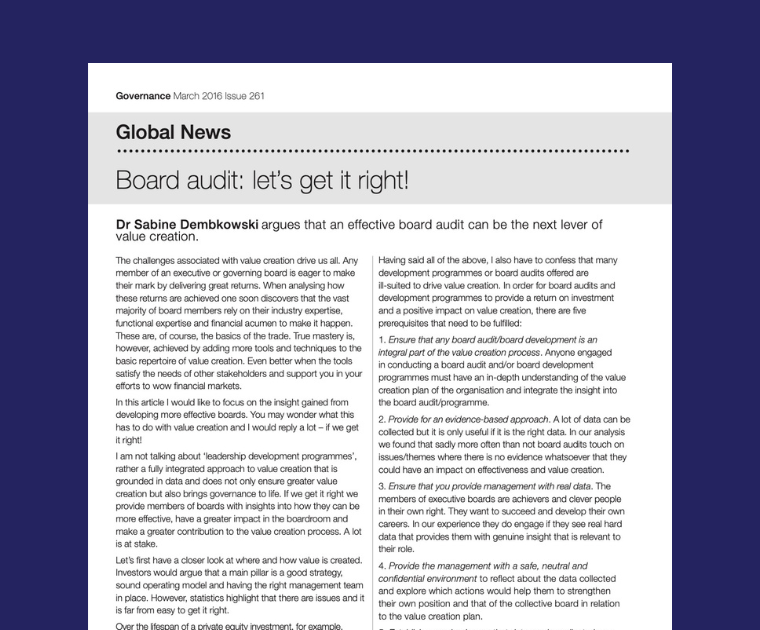Board audit: let’s get it right

Dr Sabine Dembkowski argues that an effective board audit can be the next lever of value creation.
The challenges associated with value creation drive us all. Any member of an executive or governing board is eager to make their mark by delivering great returns. When analysing how these returns are achieved one soon discovers that the vast majority of board members rely on their industry expertise, functional expertise and financial acumen to make it happen. These are, of course, the basics of the trade. True mastery is, however, achieved by adding more tools and techniques to the basic repertoire of value creation. Even better when the tools satisfy the needs of other stakeholders and support you in your efforts to wow financial markets.
In this article I would like to focus on the insight gained from developing more effective boards. You may wonder what this has to do with value creation and I would reply a lot – if we get it right!
I am not talking about ‘leadership development programmes’, rather a fully integrated approach to value creation that is grounded in data and does not only ensure greater value creation but also brings governance to life. If we get it right we provide members of boards with insights into how they can be more effective, have a greater impact in the boardroom and make a greater contribution to the value creation process. A lot is at stake.
Let’s first have a closer look at where and how value is created. Investors would argue that a main pillar is a good strategy, sound operating model and having the right management team in place. However, statistics highlight that there are issues and it is far from easy to get it right.
Over the lifespan of a private equity investment, for example, there is a CEO turnover rate of over 50 per cent and an even higher number relating to other board members compared to a 15 per cent rate in the world’s 2,500 largest public companies. In around 50 per cent of the cases the change in CEO was not planned and is due to underperformance of the individuals. This ‘underperformance’ is, in many cases, simply caused by a mismatch of the skill set with the requirements after a change in strategy, ‘human incompatibility’ with other board members, the inability to gain the trust of the shareholder, lacking empathy to convince within the organisation and not acting as a role model for the employees – to name but a few. Another study highlights that actually over 50 per cent of CEOs lose monies for their investors.
Given that management is the key enabler and driver of value creation it is quite surprising how little effort is presently put into the systematic development of executive boards. Should this not be one of the key tasks of chairmen and actually one they are measured on?
Having said all of the above, I also have to confess that many development programmes or board audits offered are ill-suited to drive value creation. In order for board audits and development programmes to provide a return on investment and a positive impact on value creation, there are five prerequisites that need to be fulfilled:
- Ensure that any board audit/board development is an integral part of the value creation process. Anyone engaged in conducting a board audit and/or board development programmes must have an in-depth understanding of the value creation plan of the organisation and integrate the insight into the board audit/programme.
- Provide for an evidence-based approach. A lot of data can be collected but it is only useful if it is the right data. In our analysis we found that sadly more often than not board audits touch on issues/themes where there is no evidence whatsoever that they could have an impact on effectiveness and value creation.
- Ensure that you provide management with real data. The members of executive boards are achievers and clever people in their own right. They want to succeed and develop their own careers. In our experience they do engage if they see real hard data that provides them with genuine insight that is relevant to their role.
- Provide the management with a safe, neutral and confidential environment to reflect about the data collected and explore which actions would help them to strengthen their own position and that of the collective board in relation to the value creation plan.
- Establish a mechanism so that data can be collected on a continuous basis and the executive board can monitor progress. Once you have ensured that these five prerequisites are in place you need to determine which are the crucial pillars of effective boards that ensure superior returns. Our research shows that there are seven pillars of effective boards. Each pillar can drive value creation.
- The composition of the board
- The ability of the board to use the strength of its members
- Clarity about roles and responsibilities
- Development of a common vision
- The ability to resolve conflicts between the board and management
- The structure and organisation of the board’s work
- Regular reviews and reflection about the board’s work.
1. Composition of the board
This is probably the area that has received most attention to date, especially with discussions in the media about diversity and quotas for women on boards. But diversity is just a small part of the puzzle. Let´s look at what happens in practice. Organisations that have the funds tend to hire well-known headhunting firms that are briefed to find executives with a distinguished background, expertise and track record of achievements. More often than not the exercise produces a board full of ‘achievers’ and ‘alpha animals’. This type of selection provides security and the feeling among all involved that they have done a really good job. This is a well‐intentioned (but rather expensive) way to form a board and by no means guarantees superior returns. On the contrary – the chances that such groups really work well together are rather slim. This is not a question of education, experience or past achievements; it is a question of complementary personalities, behaviours and fit. Very few recruiters and firms look at this stage systematically for these criteria.
2. The ability of the board to use the strengths of its members
The awareness of board members of their own strengths and how they can use them best varies enormously. Some are highly aware but others are far less so. In our own practice we find that they use their strength more by accident than by conscious decision. This lack of understanding becomes even more acute when they are questioned about the strengths of other board members. They are seldom able to describe them in more than general terms. Sadly, this means that one of the most powerful ways to increase the effectiveness of boards remains underused. Seasoned board members are often unwilling to learn but we have found that the new generation of directors has a different attitude. Encouragingly, they are highly interested in learning about themselves and how they can become more effective.
3. Clarity about roles and responsibilities
Roles and responsibilities are not as clearly defined as one may wish. Some ‘grow’ over time or are the result of a specific initiative of an individual board member and tailored around his agenda, skills and needs. We have seen substantial ‘grey areas’ of responsibility on many boards. The existence of these areas leads to situations where unpleasant or uncomfortable tasks and decisions remain unaddressed or delayed. This can cause conflict on a daily basis and waste or even destroy resources that could be used to create value for the organisation and its stakeholders.
4. Development of a common vision
This sounds so simple and obvious – but in practice it proves to be a real and at times insurmountable challenge. Developing a shared vision and gaining the approval and commitment of all stakeholders is a process. The communication of a shared vision is essential: nothing is more damaging to a company than the revelation that there are disagreements on the board about vision, strategy and subsequent action to be taken.
5. The ability to resolve conflicts between the board and management
Now more than ever it is the challenge of a board to lead ‘highly educated people with great potential’ who are sensitive, observant and understand what the board is saying or not saying, doing or not doing. Executives at one or two levels below the board have mostly been to first-class universities or business schools and have their own ideas about the company and its direction. This can lead to covert or even open conflict. Board members are more than ever challenged to convince these executives with the quality of their argument and personality, to analyse conflicts and solve them. The size of this challenge should not be underestimated. A coalition or alliance between the board and management will be crucial for success. The board can serve as a role model for the development of a culture where conflicts are resolved constructively. The solid behaviour of board members in a conflict will be decisive for the culture of the organisation. Harmony is rare when an organisation wants to leverage and realise its full potential.
6. The structure and organisation of the board’s work
Many board members have told us in onboarding coaching programmes that they were ‘completely lost’ on joining the board and had to learn how to operate at that level the hard way, over time. The work of many governing boards is poorly structured and new members have to ‘settle’ into a system that works for those in the know but is not necessarily well‐ structured or logical to those observing or joining it. This is a factor that deserves more attention; much can be done to improve the organisation of the board’s work, often at little cost but with a highly positive effect on the organisation. Again, what happens at board level will be mirrored at lower organisational levels.
7. Regular reviews and reflection about the board’s work
Regular shared time out, where people have the opportunity to connect with each other and reflect on their work, is appreciated by many practitioners and highlighted by writers around the world as a crucial component of any best practice process. In fact, in the literature on the work of boards, it is the one point on which there is overwhelming consensus. With this level of agreement, why do so few boards plan time‐out on a regular basis?
Each and every single issue and pillar detailed here can provide directors with a lever to achieve the goals set out in the value creation plan, increase their level of impact and be more effective. However, when we analysed different approaches to board audits we have never seen all these areas covered.
An evidence based board audit that shows real data in relation to the areas that make a board more effective as proposed here and shies away from well-meant but ‘subjective’ interpretations. It provides insights that are meaningful and provides the basis for an action plan for each and every member of the board as well as the collective. It delivers the solid foundation that is needed to realise ambitious value creation plans.
This article was published in GOVERNANCE March 2016 Issue 261.



